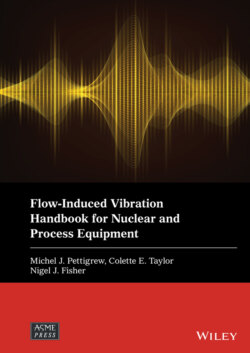Читать книгу Flow-Induced Vibration Handbook for Nuclear and Process Equipment - Группа авторов - Страница 33
Heat Exchanger Tubes in Liquids
ОглавлениеAs discussed in Chapter 5, there are three important energy dissipation mechanisms that contribute to damping of multi‐span heat exchanger tubes with liquids on the shell‐side. These are viscous damping between tube and liquid, squeeze‐film damping in the clearance between tube and tube support, and friction damping at the support. Thus, the total tube damping, ζT, which we define as the ratio of actual to critical damping in percent, is expressed by
(2‐14)
where, ζV, ζSF and ζF are, respectively, the viscous, squeeze‐film and friction damping ratios.
Tube‐to‐fluid viscous damping is related to the Stokes number, πfD2/2v, and the degree of confinement of the heat exchanger tube within the tube bundle or D/De. Rogers et al (1984) developed a simplified formulation for viscous damping, valid for πfD2/2v > 3300 and D/De < 0.5 which covers most heat exchangers. Their simplified expression for ζV(in percent) is
(2‐15)
where v is the kinematic viscosity of the fluid and f is the natural frequency of the tube for the mode being analysed. Clearly, viscous damping is frequency dependent. Calculated values of damping using Eq. (2-15) are compared against experimental data in Fig. 2-7. The comparison shows reasonable agreement.
Squeeze‐film damping, ζSF, and friction damping, ζF, take place at the supports. Semi‐empirical expressions were developed, based on available experimental data, to formulate friction and squeeze‐film damping as discussed by Pettigrew et al (2011) and in Chapter 5. The available experimental data is outlined in Fig. 2-8. Thus, squeeze‐film damping (in percent) may be formulated by
(2‐16)
and friction damping (in percent) by
(2‐17)
where (N − 1)/N takes into account the ratio of the number of supports over the number of spans, L is the support thickness and ℓm is a characteristic tube length. The latter is defined as the average of the three longest spans when the lowest modes and the longest spans dominate the vibration response. This is usually the case. When higher modes and shorter spans govern the vibration response, then, the characteristic span length should be based on these shorter spans. This could happen when there are high flow velocities locally, such as in entrance or exit regions.
Fig. 2-7 Viscous Damping Data for a Cylinder in Unconfined and Confined Liquids: Comparison Between Theory and Experiment.
Fig. 2-8 Damping Data for Multi‐Span Heat Exchanger Tubes in Water.
Fig. 2-9 Comparison Between Tube Support Damping Model (Squeeze‐Film and Friction) and Experimental Data.
Equations (2-16) and (2-17) are combined to determine the squeeze‐film damping parameter, 1460/f, and compared against available experimental data in Fig. 2-9. There is large scatter in the data, which is mostly due to the nature of the problem. Heat exchanger tube damping depends on parameters that are difficult to control, such as support alignment, tube straightness, relative position of tube within the support, and side loads. These parameters are statistical in nature and probably contribute to much of the scatter. A conservative but realistic criterion for damping is obtained by taking damping values at roughly the lower decile of the available data, as shown in Fig. 2-8.
Substituting Eqs. (2-15), (2-16) and (2-17) in Eq. (2-14):
(2‐18)
Although somewhat speculative, Eq. (2-18) formulates all important energy dissipation mechanisms and fits the data best. Thus, it is our recommendation as a damping criterion for design purposes.
However, if the damping ratio predicted by this equation is less than 0.6%, we recommend taking a minimum value of 0.6%. As shown in Fig. 2-8, a minimum damping of 0.6% appears reasonable. In Fig. 2-8, there is no experimental data for frequencies below 25 Hz. Rather than extrapolating Eq. 2-18 to lower frequencies, we recommend using a maximum total damping of 5%.
